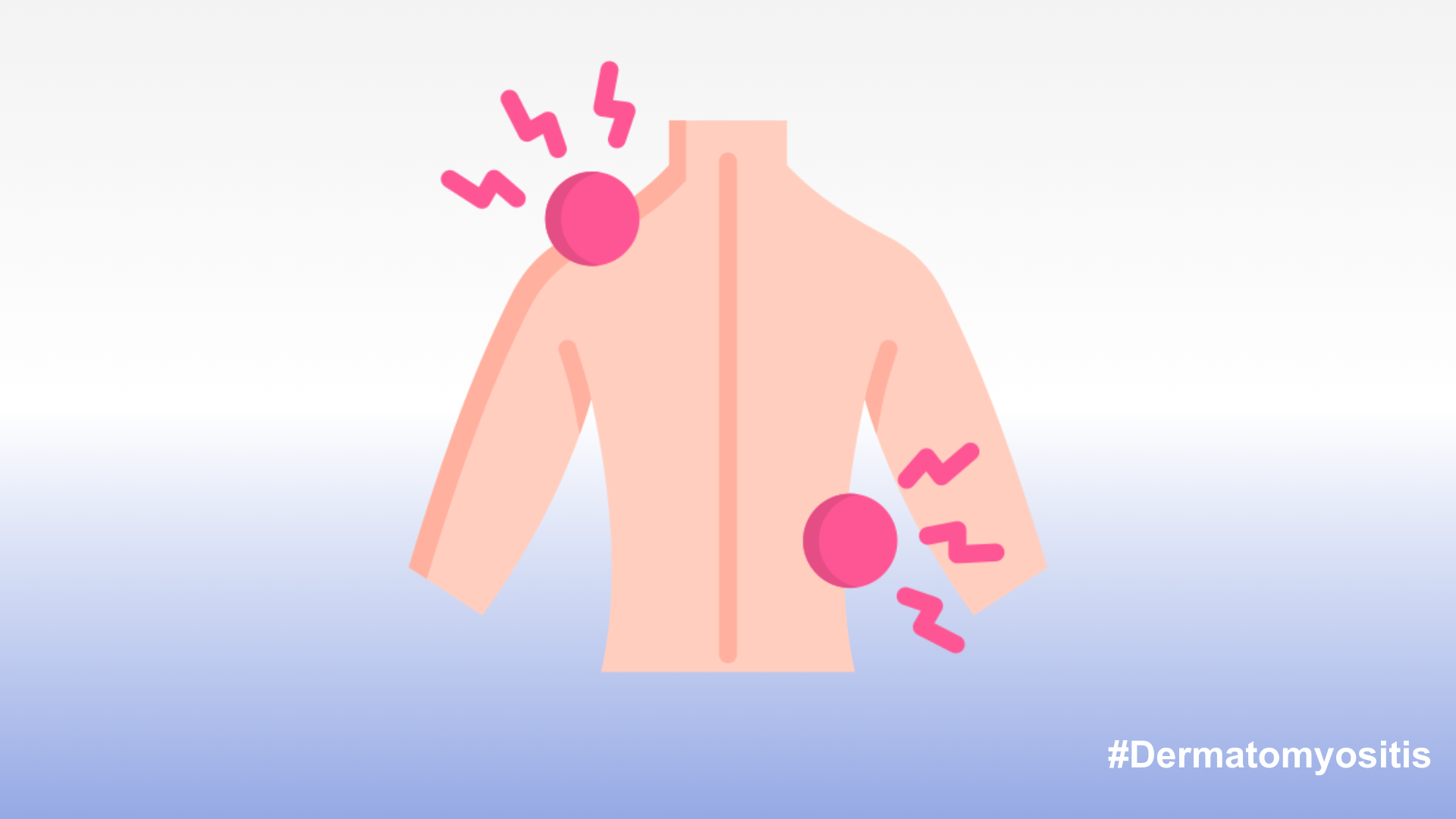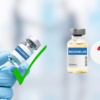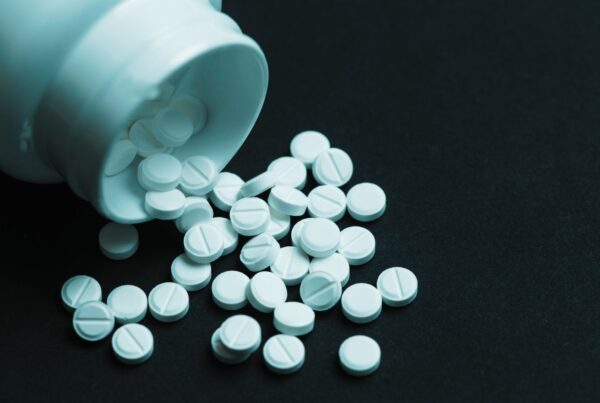Introduction
Dermatomyositis is a severe condition that, although uncommon, can potentially lead to fatal outcomes. Early diagnosis and prompt initiation of treatment are crucial. While a definitive cure for dermatomyositis does not currently exist, symptoms can frequently be controlled with the use of medications and physical therapy, often required for the long term or even throughout life.
What Is Dermatomyositis?
Dermatomyositis, a rare inflammatory myopathy, is characterized by myofiber inflammation leading to symmetric proximal muscle weakness. Additionally, it presents with characteristic cutaneous findings, including a distinctive skin rash, and may involve extramuscular manifestations such as esophageal and pulmonary involvement. Notably, dermatomyositis exhibits a strong association with malignancy, particularly in the adult population.
This idiopathic inflammatory disorder demonstrates both inflammatory and degenerative changes in muscles and skin, affecting individuals across all age groups. Its etiology remains elusive, and while it primarily targets the integumentary and musculoskeletal systems, it can also impact the gastrointestinal, respiratory, and cardiovascular systems.
Complications, such as dystrophic calcinosis, may arise, predominantly in pediatric patients. While definitive treatment is lacking, symptom management strategies are employed. Dermatomyositis typically presents in adulthood between the ages of 40 to 60, and in childhood between 5 to 15 years. Early diagnosis and comprehensive management are imperative in optimizing patient outcomes in this complex disorder.
Patient’s Story
- Suhani Bhatnagar, the young actress celebrated for her role in “Dangal,” met an untimely demise due to dermatomyositis. Her family disclosed that Suhani had been grappling with this condition, and despite receiving care at the All India Institute of Medical Sciences, she ultimately succumbed to its complications. Dermatomyositis, known for its multi-systemic impact, led to severe lung damage and fluid buildup, exacerbating her condition. Suhani’s symptoms surfaced two months before her passing, but it took ten days to confirm the diagnosis.
- Renowned Indian actress Samantha Ruth Prabhu shared her battle with myositis on Instagram, describing months of muscle pain and fatigue before diagnosis. She discussed treatment with steroids and immunosuppressants. Samantha’s post urged fans to prioritize health, emphasizing mental well-being and self-care amidst her struggle with myositis. Despite the challenges posed by her diagnosis, Samantha recently revealed her plans to return to work and participate in a health podcast project, demonstrating her resilience and determination.
Both Suhani Bhatnagar and Samantha Ruth Prabhu’s journeys highlight the significant impact of rare diseases like dermatomyositis and myositis. Their stories emphasize the urgent need for heightened awareness, research, and support for individuals battling such conditions, inspiring others to prioritize their well-being.
Dermatomyositis vs Lupus
Both dermatomyositis and lupus are autoimmune disorders, presenting challenges in their differentiation due to overlapping symptoms. Dermatomyositis typically manifests with muscle weakness and skin rash, whereas lupus may induce joint pain, skin sensitivities and rashes, and complications involving internal organs such as the brain, lungs, kidneys, and heart. In dermatomyositis, the rash often exhibits a purple-red hue and is commonly found on the eyelids and joints, whereas lupus-associated rash tends to present as a butterfly-shaped rash on the cheeks and bridge of the nose.
Impact of dermatomyositis on daily living
Dermatomyositis exerts a substantial influence on daily life, affecting muscle strength, skin health, and internal organ function. Muscle weakness induced by the condition impedes basic activities like stair climbing, hair grooming, and object lifting, contributing to fatigue and diminished mobility. Challenges in swallowing and speaking may arise, alongside discomfort from the skin rash and associated symptoms, potentially impacting self-perception. Severe cases may give rise to complications such as respiratory difficulties, cardiac issues, and heightened susceptibility to specific cancers.
Incidence And Prevalence Worldwide
- The average worldwide incidence of dermatomyositis is estimated to be between 9.63 and 13.98 cases per million people per year.
- The incidence of dermatomyositis varies depending on the population studied and geographical location. For instance, a retrospective study in Olmsted County, Minnesota, between 1967 and 2007 found an incidence rate of 9.63 per 1,000,000 people.
- In Alberta, Canada, from 2013 to 2019, the average age- and sex-standardized annual incidence was 2.8–3.0 cases per 100,000 adults, with a prevalence of 28.6 cases per 100,000 adults. In a nationwide cohort study of US veterans from 2005 to 2019, the incidence ranged from 0.1 to 1.8 cases per 100,000 person-years.
- Dermatomyositis is more commonly observed in women, with incidence rates of 3.98 and 4.68 per 1,000,000 for women and men, respectively. It frequently affects individuals aged 40 to 50, with the mean age at diagnosis being 44.0 ± 18.3 years.
- A study analyzing administrative claims data from Quebec, Canada, covering around 7.5 million beneficiaries, approximated the prevalence of dermatomyositis (DM) and polymyositis (PM) at 21.5 per 100,000 patients, with a 95% confidence interval ranging from 19.4 to 23.9.
- The overall incidence rate of dermatomyositis is approximately 1 in every 100,000 people per year. While it can occur across all age groups, it is more prevalent in women. Prevalence rates range from one to 22 cases per 100,000 people.
Signs and Symptoms
Typically, the initial symptom of dermatomyositis is the appearance of a characteristic skin rash, commonly observed on the face, eyelids, chest, nail cuticle areas, knuckles, knees, or elbows. This rash often presents as patchy and typically exhibits a bluish-purple hue.
Additionally, a rash observed on the chest often manifests in a shawl-like pattern, hence termed the “shawl sign.” Similarly, a rash appearing on the hands may be referred to as “mechanic’s hands” due to its characteristic rough and dirty appearance of the skin.
Dermatomyositis can manifest with varied signs and symptoms, often showing an unpredictable course of progression including,
Muscle Weakness: A predominant symptom, typically affecting proximal muscles such as those in the shoulders, hips, and thighs. This weakness can lead to difficulty performing routine tasks like climbing stairs, rising from a seated position, or lifting objects.
Pain and Stiffness: Muscles may become sore, achy, and stiff, complicating movement and causing discomfort.
Fatigue: Easily experiencing tiredness and a general lack of energy is common among those with dermatomyositis.
Skin Changes: Characteristic skin abnormalities often precede muscle weakness in up to 40% of cases. These changes may include a reddish-purple or lilac rash, known as the “heliotrope rash,” commonly observed on the upper eyelids, forehead, cheeks, and bridge of the nose.
Additionally, skin on extensor surfaces like knuckles and elbows may exhibit scaly patches with central tissue loss (Gottron sign). Other skin manifestations include a dusky reddish rash on the upper arms, legs, and trunk, often accompanied by itching and sleep disturbances.
Nail and Scalp Changes: Abnormalities in the nails, such as bluish-red scaling lesions and shininess of nail folds, can occur. Itching and scaling lesions on the scalp may lead to significant hair loss.
Additional Symptoms: Low-grade fever, malaise, dyspnea, polyarthralgia, weight loss, and Raynaud phenomenon (sudden blood vessel contraction in fingers and toes) may also be present. Some individuals may experience complications such as GI tract, cardiovascular, or lung involvement, including cardiomyopathy, arrhythmias, and interstitial lung disease. Rarely, dermatomyositis may be associated with underlying malignancies, predominantly observed in adults over the age of 40-50.
Childhood Dermatomyositis: Symptoms and physical findings are similar to adult dermatomyositis but often have a more sudden onset and frequent skin manifestations preceding muscle weakness. Calcification of muscles and tissues, widespread inflammation of blood vessels (vasculitis), and GI involvement may be more common in childhood cases. Rarely, skin abnormalities may occur without muscle involvement, termed as dermatomyositis sine myositis.
The cause of dermatomyositis is not fully understood, but it’s thought to involve a combination of genetic factors, immune system abnormalities, and environmental triggers. Specific human leukocyte antigens (HLAs) and genes associated with autoimmune diseases may contribute to susceptibility. Abnormal immune responses target muscle and skin tissues, leading to inflammation and tissue damage. The interferon (IFN) pathways, especially type I IFNs, play a key role in the disease process, as evidenced by the presence of an IFN signature in affected tissues.
Pathophysiology
In dermatomyositis, the immune system mistakenly attacks muscle fibers and blood vessels, leading to muscle weakness and pain. Concurrently, the skin is also affected, with immune-mediated damage resulting in characteristic rashes, typically appearing on the face, eyelids, knuckles, and elbows.
Immune dysregulation of the interferon pathway, particularly type I interferons, plays a significant role in the pathophysiology of dermatomyositis, contributing to inflammation and tissue damage. Understanding these underlying mechanisms is crucial for developing targeted therapies to manage this complex autoimmune condition.
The Severity Of Conditions
Dermatomyositis varies greatly in severity among different individuals. The disease can range from mild to severe, with some cases potentially becoming life-threatening. Severe forms of dermatomyositis may lead to complications such as contractures, pulmonary involvement, cardiopulmonary failure, and an increased risk of developing associated malignancies.
Factors increasing the likelihood of a poor prognosis include an associated malignancy, older age (> 60 years), and the presence of cardiac, pulmonary, or esophageal involvement. Additionally, approximately 5% of patients with dermatomyositis have a fulminant progressive course with eventual death.
However, about 20% of people with dermatomyositis go into long-term remission. Early diagnosis and prompt initiation of treatment significantly improve outcomes and help prevent severe complications.
Prognosis
- According to research findings, the long-term prognosis of dermatomyositis varies significantly among individuals.
- A study published in the Annals of Internal Medicine found that out of 69 patients, 30 deaths (43.5%) occurred mainly due to cardiovascular, pulmonary, carcinomatous, and iatrogenic complications.
- Factors such as old age, cancer, pulmonary interstitial fibrosis, and asthenia-anorexia were identified as significant prognostic factors for death in dermatomyositis patients.
- Another study noted that patients with dermatomyositis and polymyositis have a mortality risk of over 10%, with causes often related to cancer and pulmonary complications.
- Age at onset of myositis, disease duration before treatment initiation, and presence of myositis-associated autoantibodies were analyzed as potential prognostic factors.
- Overall, advanced age, cancer, pulmonary and cardiac involvement, and severe muscle weakness upon presentation are indicators of higher mortality and poor outcomes.
- Long-term outcomes range from 18% to 90% favorable outcomes, with mortality rates varying from 4% to 45%, primarily due to associated cancer and pulmonary complications.
Early intervention and close monitoring significantly impact the prognosis of dermatomyositis.
Diagnosis
Diagnosing dermatomyositis typically involves a comprehensive approach combining clinical assessment, laboratory tests, and tissue sampling procedures. Initially, a detailed medical history and physical examination are conducted to identify symptoms like muscle weakness, skin rash, and associated issues such as swallowing or breathing difficulties.
Laboratory investigations play a crucial role in assessing muscle enzyme levels, including creatine kinase (CK), aldolase, and lactate dehydrogenase (LDH), indicating muscle injury. Additionally, antinuclear antibody (ANA) testing may be performed to evaluate autoimmune activity.
Skin biopsy is utilized to observe characteristic features akin to systemic lupus erythematosus, such as vacuolar changes in the basal layer, heightened lymphocytic infiltrate, and increased mucin deposition in the dermis.
Muscle biopsy serves as the gold standard for confirming dermatomyositis diagnosis and ruling out alternative causes of muscle inflammation. Targeting weakened muscles or contralateral muscles enhances diagnostic accuracy.
Supplementary diagnostic tools like electromyography (EMG) measure muscle electrical activity, while magnetic resonance imaging (MRI) provides visualization of muscle inflammation.
Considering individual patient symptoms and overall health status, additional evaluations may include lung, esophageal, or cardiac function assessments, along with cancer screening, ensuring a comprehensive diagnostic approach.
Treatment and Management
Treatment for dermatomyositis encompasses various approaches:
Treatment options encompass medications or alternative therapies, with surgery being a rare recourse for removing calcium deposits. Surgical intervention aims to alleviate pain from calcifications and prevent recurring skin infections.
Systemic glucocorticoids, with or without immunosuppressants, constitute the primary treatment approach for muscle involvement in dermatomyositis. While there is no universally prescribed regimen for systemic steroid use in dermatomyositis, the fundamental principles of therapy remain consistent.
- Corticosteroids: These medications aim to reduce muscle inflammation, thereby alleviating symptoms.
- Physical Therapy: Engaging in structured physical therapy and exercise regimens can aid in muscle rehabilitation and strength building, enhancing their resilience against dermatomyositis-related damage.
- Immunosuppressant Medications: Immunosuppressants help dampen the immune system’s overactivity, curbing its tendency to attack healthy tissues and mitigating muscle damage progression.
- Intravenous Immunoglobulin (IVIg): IVIg infusions supplement the body with additional immunoglobulin, a component of plasma, which can complement immunosuppressant therapy or serve as an alternative treatment approach.
- Speech Therapy: For individuals experiencing muscle weakness affecting throat muscles and swallowing function, speech therapy can assist in strengthening these muscles and improving swallowing abilities.
The selection of treatments depends on the location and severity of symptoms. Consulting with a healthcare provider can provide insight into the expected treatment course and the timing of specific interventions.
Managing dermatomyositis symptoms typically requires long-term commitment, possibly for life.
- Adhere to medication schedules as directed by your healthcare provider.
- Minimize UV exposure by limiting sun exposure, avoiding indoor tanning beds, and taking frequent breaks indoors or in shaded areas when outdoors.
- Apply sunscreen with an SPF of at least 50 regularly, reapplying every two hours when outdoors.
- Regularly consult your healthcare provider for symptom monitoring and to prevent disease progression.
Physical therapy is essential in managing dermatomyositis. It includes active exercise programs and range of motion exercises to prevent contractures. For esophageal dysfunction, interventions like head elevation, feed thickening, or gastric tube use may be necessary. Treatment focuses on strengthening exercises, range of motion exercises, and passive stretching with splinting. Supervised physical therapy improves muscle strength, endurance, and functional capacity while providing education on energy conservation, joint protection, and assistive devices for daily living activities.
Bottom Line
In summary, Dermatomyositis presents a multifaceted challenge, impacting both muscular and cutaneous health. Through a deeper understanding of its underlying mechanisms, we can refine diagnostic strategies and enhance treatment approaches. Let us prioritize proactive screening efforts to detect Dermatomyositis early, enabling timely interventions and improved patient outcomes. Together, let’s advocate for comprehensive screening protocols as an integral part of healthcare practices, ensuring better management and support for individuals affected by this condition.
Written By
Aswini PriyaMedical Content Writer
Reviewed By
Dr. AnchalMedico Expert
Last Updated
21 Feb 2024 | 10:15 AM (IST)










